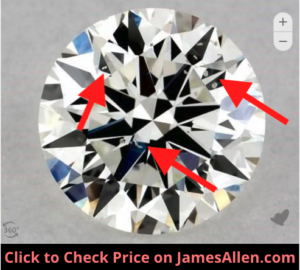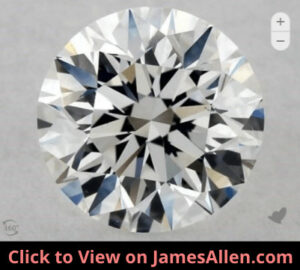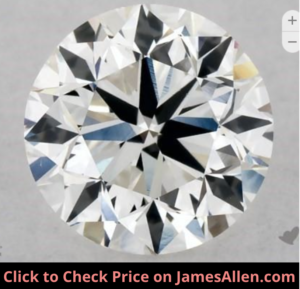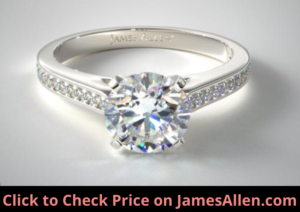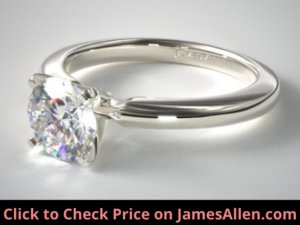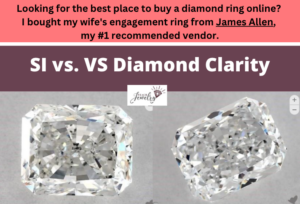
SI (slightly included) and VS (very slightly included) are two grades on the diamond clarity scale. These categories are broken down into SI1, SI2, VS1, and VS2.
The main difference between SI and VS diamonds is SI diamonds have larger inclusions that affect their appearance, durability, and brilliance. VS diamonds have inclusions often invisible to the naked eye, which is why they’re a popular choice for engagement ring diamonds.
When I was shopping for an engagement ring for my now-wife, eye-cleanliness was a priority. For that reason, I chose a VS1 diamond.
We’ll compare SI versus VS diamonds, including an overview of each clarity grade, five differences, and how to decide which is right for you.
What are SI Clarity Diamonds?
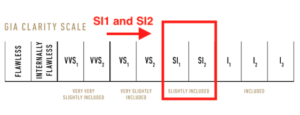
SI diamonds have inclusions that are easy to identify with magnification. There are often many types found inside their facets.
The diamond below earned an SI clarity grade, and I’ve highlighted inclusions you can view in high-resolution.
When gemologists are determining a diamond’s clarity, they’ll use a jewelers loupe with 10x magnification to scan back and forth. For diamonds toward the top of the scale, like VS1 or VVS1, they may not notice flaws with a quick glance.
This isn’t the case with SI diamonds. Some of the inclusions they’ll find include:
- Twinning wisps
- Feathers
- Etch channels
- Clouds
- Indented naturals
They’ll often be scattered across the diamond’s table and pavilion.
For example, this one-carat diamond earned an SI1 clarity grade. The GIA report notes six types of inclusions in its facets.
The top-down and bottom-up views on the clarity characteristics plot confirm inclusions are visible at almost every angle.
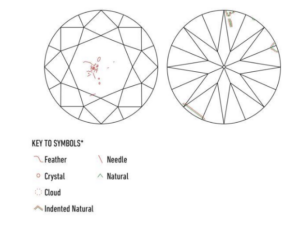
The image of the diamond confirms the information on this report. Inclusions are visible in multiple places.
To further distinguish the extent of inclusions, the GIA scale divides the SI category into SI1 and SI2.
SI1
SI1 is the higher clarity grade within the SI diamond category.
It’s often the minimum clarity grade buyers choose for an engagement ring diamond because SI1 diamonds under 1.5 carats can appear eye-clean.
As an example, there aren’t any inclusions visible in this image of a 0.75-carat diamond.
I suspect it’s eye-clean, but the only way to know is to view it in person.
SI2
SI2 is one position below SI1 and one above the included category, abbreviated “I”.
Even small SI2 diamonds often have visible inclusions, so they aren’t a popular choice for engagement rings. It’s often the lowest clarity grade available from diamond retailers because there’s such low demand for included gems.
You’ll typically find a high number of inclusions in SI2 diamonds compared to SI1 and above, and many are large. If the report notes only one or two flaws, know they’re likely significant in their size and impact.
What are VS Diamonds?
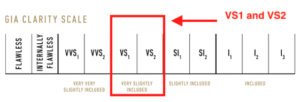
VS diamonds are toward the middle of the GIA clarity scale. They’re one position below very, very slightly included (VVS) and above SI.
Diamonds are assigned this clarity grade because inclusions are often easy to spot at 10x magnification but generally invisible to the naked eye.
Here’s a VS diamond.
Notice how there aren’t any obvious inclusions on its table.
But VS diamonds feature the same kinds of inclusions found in other clarity grades. There may be a white twinning wisp near its crown, several pinpoints on its table, or a small etch channel.
As an another example, I found a 0.76-carat diamond with clouds and needles.
These are some of the same inclusions as the SI diamonds above, but they’re smaller and in less prominent positions.
VS diamonds are often used in engagement rings. In fact, if you’re choosing a diamond heavier than 1.5 carats, you could start your search in this category.
Similar to the SI category, VS clarity is also broken down into VS1 and VS2.
VS1
VS1 is one clarity grade higher than VS2 and one below VVS2.
It’s the clarity grade I chose because I wanted a diamond that was eye-clean at a strong value. VS1 diamonds often meet this criteria.
When a gemologist is assessing a VS1 diamond, they may have to scan back and forth a few times before identifying all the inclusions.
Small ones like pinpoints or faint black spots aren’t always immediately noticeable in these diamonds.
The image below of a VS1 diamond engagement ring is a helpful example.
It has common types of inclusions but appears eye-clean.
VS2
The inclusions in a VS2 diamond are slightly more frequent or impactful than ones in VS1 diamonds.
They aren’t as difficult to identify with a jewelers loupe and are sometimes located in each area of the diamond, from its table and crown to the pavilion.
VS2 is often the right starting point for fancy shapes like emerald and princess cuts because they don’t disguise inclusions as well as round cuts.
But with fancy shapes, pay attention to inclusions located in vulnerable positions such as sharp corners. Although VS2 inclusions are often small, they still increase the likelihood of chips.
How are SI and VS Diamond Clarity Different?
1. SI Diamonds Often Have a Higher Number of Inclusions
In most cases, SI diamonds have more inclusions than ones that earn a VS grade.
The total number of inclusions is only one consideration in designating clarity, but if the inclusions are a similar size and type, the total number could sway the final grade higher or lower.
Let’s compare this 0.77-carat VS2 diamond (left) and this 1.20-carat SI2 diamond (right), pictured below.
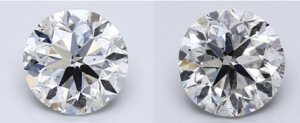
The VS2 diamond has the following inclusions:
- Crystal
- Indented natural
- Cloud
The SI2 diamond has eight, including all the ones present in the VS diamond, plus:
- Twinning wisps
- Feathers
- Cavity
- Needles
- Naturals
A higher number of inclusions has a negative impact on the diamond. It’s rare to find one with more than six types that earns a grade above SI.
But there are exceptions to this rule. I’ve seen diamonds earn a SI2 grade because of a single crystal that affected every aspect of its appeal.
2. VS Diamonds are Often Eye-Clean
Most buyers aren’t concerned with the exact number and type of inclusions present. Instead, they focus on how the diamond appears to the naked eye.
After all, no one besides the gemologist will view it under magnification. So how the inclusions look under a jewelers loupe often doesn’t impact the decision.
That’s why many buyers start their search with VS diamonds. They have a higher likelihood of appearing eye-clean if they’re less than two carats.
The inclusions present within their facets are often small, white, or transparent. Large black spots or dark crystals often result in an SI1 or SI2 grade.
Eye-cleanliness also lends itself to improved brilliance because inclusions distort the way light enters and exits the diamond.
This diamond engagement ring features a 1.5-carat VS1 diamond.
Its inclusions aren’t visible in the high-quality photos despite its high carat weight.
Choosing an eye-clean VS diamond over a VVS or flawless diamond results in significant cost savings. I created the same engagement ring as the one above but with a VVS1 diamond, and the cost is almost 40 percent higher.
So my recommendation is to prioritize eye-cleanliness instead of an exact clarity grade. Start by examining SI diamonds, but you’ll often find yourself moving up to VS clarity grades.
3. SI Diamonds are More Affordable
The reason some choose SI diamonds over VS is affordability. But I caution buyers all the time to not sacrifice eye-cleanliness to save on price.
There’s higher demand for ones with fewer flaws because of the way inclusions affect every aspect of the diamond.
The cost also increases because diamonds with minimal imperfections are rare.
To best understand the differences in price between VS and SI diamonds, I compared prices of 173 round-cut diamonds from James Allen.
They all had the following qualities:
- Carat weight: 0.9
- Color: F
- Cut: Very good
Diamonds with SI2 clarity sold for an average of $3,711, with a range of $2,880-$4,630.
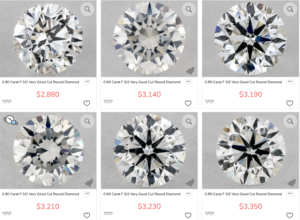
For SI1 clarity, the average price was $4,662, and the range was $4,110-$5,240.
For VS2 clarity, the average was $5,689. They were priced between $4,900-$7,190.
VS1 clarity diamonds with those qualities average $6,118 and range from $4,930-$7,030.
This analysis demonstrates SI diamonds are less expensive than ones graded VS.
Each step up the clarity scale increases the price by between 15 and 25 percent.
So by finding an eye-clean diamond with a lower clarity grade, you can put that savings toward improvements in other qualities like its carat weight, color, or cut grade.
4. VS Diamonds are More Durable
The durability of a diamond refers to its ability to withstand hits, drops, or mountings without chipping.
Diamonds are the hardest naturally-occurring substance on Earth, but inclusions have the potential to weaken them in vulnerable areas.
VS diamonds are more durable because the inclusions are often smaller and in stronger positions.
For example, the corners of fancy shapes like marquise, princess, and baguette cuts are more susceptible to chipping compared to the curved edges of a round cut.
Let’s assume you’re checking out a marquise cut with an SI2 clarity grade. When you view the grading report, you learn inclusions are scattered across its table and pointed ends.
In that case, I would recommend choosing a higher grade to ensure the flaws aren’t visible, but there could also be durability concerns.
As another example, check out this marquise cut diamond.
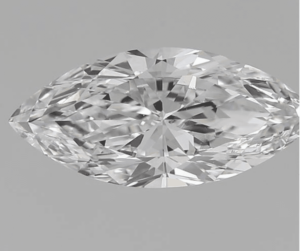
It’s graded VS1, and the inclusions aren’t located on either end.
It meets the criteria of eye-cleanliness and avoiding the durability issues posed by imperfections like feathers and cavities in those locations.
5. SI Diamonds are More Common
Most diamonds are sourced with heavy inclusions. They have so many flaws and dark specks throughout their facets that they have little value in the market.
As an example, less than one percent of diamonds qualify for a VVS1, flawless, or internally flawless grade.
A higher percentage earn SI or VS clarity grades, but SI diamonds are still more common. In fact, only the top 20 percent of diamonds are considered at least VS2 clarity.
This explains the price differences between these clarity grades. Because a smaller percentage of mined diamonds are clean enough to earn VS grades, jewelers sell them at a premium.
You’ll also notice this distinction when shopping at an in-person or online jewelry store. There’s often far more diamonds available at the SI level compared to VS and above.
This is partly attributable to demand and that buyers are often searching at a lower price point, but also that SI diamonds are far more common that ones with higher grades.
Should You Choose an SI or VS Diamond?
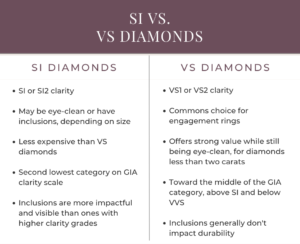
Choosing between an SI versus VS diamond involves understanding how inclusions impact price and performance.
Here are some tips.
Consider an SI diamond if:
- You’re choosing a diamond that’s less than one carat
- You view it in-person or through high-resolution images before you buy it, so you can learn whether its inclusions are noticeable
- The diamonds are small accents placed to support the main one
Opt for a VS diamond if:
- You’re searching for an eye-clean diamond that avoids the premium prices for higher clarity grades
- It’s a fancy cut, where the facets don’t hide inclusions in the same way as round cuts
- You want a higher degree of certainty the diamond won’t show inclusions
I recommend VS2 and VS1 diamonds, but start your search at SI1. If you find an eye-clean SI1 diamond, you’ve found exceptional value.
By comparing SI versus VS diamonds at in-person and online vendors, you’ll find the perfect ring for you.

Jacob Clarke
Jacob Clarke is the founder of TeachJewelry.com.
He earned an Applied Jewelry Professional Diploma from the Gemological Institute of America (GIA) and now brings you essential information about diamonds, settings, and more.
Jacob has consulted with leading jewelry brands, and his work has been cited in Clean Origin, Diamond Nexus and industry publications.
He's also a member of the International Gem Society.
He enjoys discussing jewelry with readers, so contact him with any questions at jacob.clarke@teachjewelry.com.

